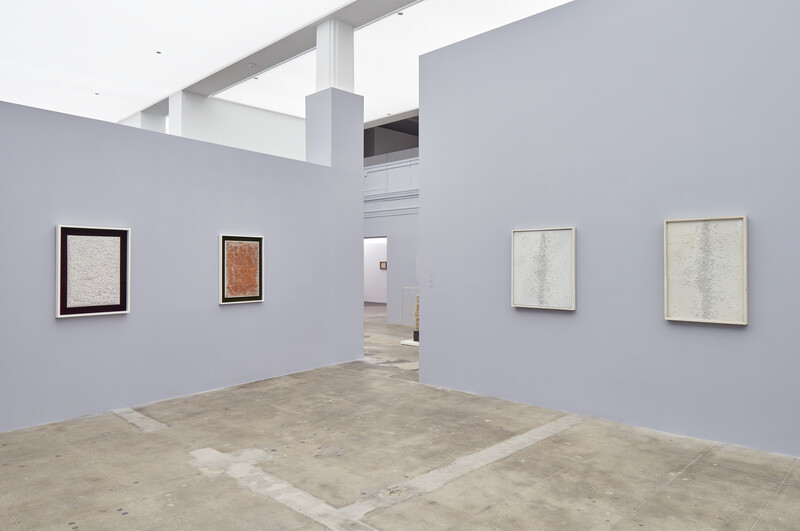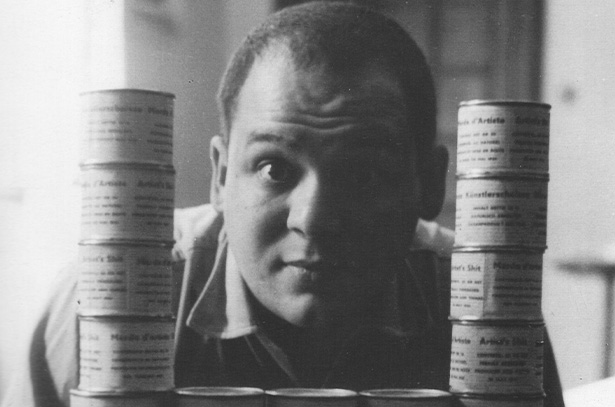
Piero Manzoni
Materials of His Time
14 February - 7 April 2019
Los Angeles
‘Piero Manzoni. Materials of His Time’ is the first exhibition with the gallery and the first in Los Angeles in over 20 years devoted to the seminal figure of postwar Italian Art and progenitor of Conceptualism. Curated by Rosalia Pasqualino di Marineo, director of the Piero Manzoni Foundation in Milan, this exhibition focuses on Manzoni’s revolutionary approach to unconventional materials through the exploration of what he dubbed ‘Achromes’ – paintings without color. Over 70 ‘Achromes’ will be on view, comprised of such materials as sewn cloth, cotton balls, fiberglass, synthetic and natural fur, straw, cobalt chloride, polystyrene, stones, and more. The exhibition situates Manzoni as a peer of such artists as Lucio Fontana and Yves Klein, whose experiments continue to influence contemporary art-making today. ‘Materials of His Time’ will also present, for the first time, the items on a wish list Manzoni outlined in a 1961 letter to his friend Henk Peeters: a room all in white fur, and another coated in fluorescent paint, totally immersing the visitor in white light.
Complementing the exhibition is a special presentation of archival material from the collection of Guido and Gabriella Pautasso in the Book & Printed Matter Lab. Books, documents, and typewritten manuscripts authored by Manzoni shed light on the inner workings of his mind and artistic method. Tracing the artist’s biography through the display of archival materials that accompanied Manzoni’s practice adds another dimension to his life, reanimating his personal and creative journey for a contemporary audience.
This exhibition will subsequently travel to Hauser & Wirth New York, where it will be shown alongside ‘Piero Manzoni. Lines,’ a presentation of another significant series by the artist that began in 1959. On the occasion of these concurrent shows, Hauser & Wirth Publishers will release two new catalogues focused on the two major bodies of work.
About the Exhibition
Piero Manzoni initiated a paradigmatic shift in the status and function of the painting medium when he eliminated traditional materials from his practice in 1957, and began a series called ‘Achromes.’ He coined this term to signify the absence of color and attributed it, as title, to the white, or more aptly, colorless works produced between 1957 and his death in 1963. Shedding light on Manzoni’s innovative approach to painting, this exhibition takes its title from a text written by the artist in 1960, in which he explains: ‘Painting and pictorial problems… are not part of the modern cultural cycle: they died long ago… a new language is a total transformation, nor can it have anything to do with the old language; an artist can use only the materials (thoughts and forms) of his time.’ Of the approximately 800 Achromes he created, more than 70 will be on view at Hauser & Wirth Los Angeles, evidencing the breadth of Manzoni’s formal investigations, his retreat from the legacy of personal artistic expression, and his contribution to the foundation of Conceptualism.
In embracing a new visual language, Manzoni rejected the idea of art as a form of representation or expression; he instead emphasized the work of art as a ‘total space,’ comprising raw materials and an absence of color. He believed even two colors to be too much, as they would substantially detract from a pure and unmediated engagement with surface, texture, and form. Unlike the monochromatic works of his peers—such as Lucio Fontana’s slit canvases and Yves Klein’s paintings in the iconic hue of International Klein Blue—Manzoni’s works obviate all color relationships and thus render the inherent color of their materials neutral, colorless, or a-chromatic, as noted by the title of his ‘Achromes’ series. The first iteration of these pieces in 1957 and 1958 were created with canvas and gesso, exemplified by the sewn canvas squares of ‘Achrome’ (1959). Manzoni created subsequent Achromes using canvas and kaolin, a white clay.
In 1960, at the height of his artistic maturity and cognizant of the path he needed to follow, Manzoni’s experimentation with materials and forms exponentially grew, spurring the period of upmost productivity for this prodigious artist. The resulting Achromes inspired vast research into diverse natural, artificial, and synthetic materials, such as cotton wool, canvas, polystyrene, phosphorescent paint, and even bread, stones, and straw. These unorthodox materials can be seen in many of the works on view, including: ‘Achrome’ (1962), which comprises a four by four grid of bread rolls covered in kaolin, or ‘Achrome’ (1962), wherein tufts of stretched synthetic fiber form a rectangle.
Manzoni reflected on his process and artistic intentions, saying, ‘The question for me is that of creating an integrally white surface (yes, integrally colourless, neutral) which is completely unrelated to any pictorial phenomenon or to any element that is extraneous to the value of the surface. It is a white that is not a polar landscape, or a beautiful or evocative material, or a sensation, or a symbol, or anything else; it is a white surface that is nothing else but a white surface (a colourless surface that is nothing else but a colourless surface). Or better still it exists, and that is sufficient. It is, and to be totally is pure becoming.’ In addition to stating that the Achromes were neither a polar landscape nor representative of anything beyond their physical components, Manzoni continuously stripped content from form by eliminating associations and visual referents. Despite the range of materials and shades of white employed in creating the Achomes, their meaning remained constant. Manzoni’s various techniques evidence his search for an absolute surface. When his materials possessed an inherent color—like cobalt chloride salt or synthetic silk, as seen in ‘Achrome’ (1961)— Manzoni didn’t view this quality as a color, but rather as a property of an Achrome.
Driven by his belief that each artwork must be a ‘total space,’ Manzoni also conceived of completely enveloping environments, in which minimal spatial interventions would transform a room. Though such immersive spaces were never completed during Manzoni’s lifetime, they have been realized at Hauser & Wirth Los Angeles for the first time in this exhibition, more than half a century after their original conception. Taking direction from a wish Manzoni shared in a 1961 letter to his friend Henk Peeters, a room in all white fur and another coated in fluorescent paint have been constructed here, after a design by Stephanie Goto, effectively shrouding viewers in textured space and white light, respectively. These previously unrealized rooms further manifest his conceptual ideals, producing spaces so total that they fully occupy and employ the third dimension as medium.
Installation views



























1 / 12
Related Content
About the Artist

Piero Manzoni
The renowned Italian artist Piero Manzoni emerged as a powerful voice for the avant-garde in the 1950s, debuting as an artist at the ‘4a Fiera mercato: Mostra d’arte contemporanea’ in 1956. A self-taught painter, his work heavily featured anthropomorphic silhouettes and the impressions of objects. He began making his ‘white paintings’—later named ‘Achromes’—in 1957, at first with rough gesso and then with kaolin, as well as with creased canvases or surfaces divided into squares.
In 1959, the artist began his series which experimented with the display of inflated white balloons. The results—‘Corpi d’aria (Bodies of Air)' and ‘Fiato d’artista (Artist’s Breath),’ where balloons were poised on a tripod or wooden plinth—extended the creative experimentation first visualized in the ‘Achromes’ as Manzoni embarked upon works that used an entirely new visual language, reframing artistic interpretation. In July 1960, he presented ‘Consumazione dell’arte / dinamica del pubblico / divorare l’arte’ in Milan, during which he offered the public hard-boiled eggs with his thumbprint on them. By 1961, Manzoni was signing actual people, turning them into ‘living sculptures,’ and awarding them with a certificate of authenticity.
Alongside his work as an abstract avant-garde painter, Manzoni contributed to and collaborated with numerous artist groups and initiatives. As his artistic activity intensified, he began participating in group shows and signing manifestos alongside other artists, including Enrico Baj, Guido Biasi, Ettore Sordini, and Angelo Verga. For a period of time he embraced the Movimento Arte Nucleare, before abandoning it in 1958.
On several occasions, he showed his work with Agostino Bonalumi and Enrico Castellani, and he collaborated with artists of the Zero group in Düsseldorf and other European neo-avant-garde groups. In 1959, he founded the Galleria Azimut in Milan with Castellani, opening the gallery with an exhibition of his ‘Linee (Lines).’ The pair simultaneously published two issues of the Azimuth magazine. The second issue (1960) included one of Manzoni’s seminal texts ‘Libera dimensione’ or ‘Free dimension.’
Current Exhibitions
1 / 12



















